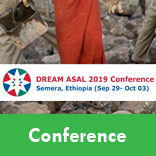Strengthening Resilience in Arid and Semi-Arid Lowlands
 |  |  |  |  |  |
 |  |  |  |  |  |
 |  |  |  |  |  |
Agro-pastoralism is a livelihoods system that integrates crop pduction and livestock production, practiced among settled, nomadic, and transhumant communities. The type of livestock varies based on culture, climate, environment, topgrapahy, geography, and hydrology. Agro-pastoral systems demonstrate the complementary and symbiotic relationship between agriculture and pastoralism.
Apart from being a way in which a number of rural communities sustain themselves, agro-pastoralism is a Climate Change mitigation option (according to the UNCCD). It is a system that can help boost land productivity, reduce soil erosion, and improve nutrient and water-use efficiency. Agro-pastoralism can also indirectly enhance resilience and land-based climate change mitigation by reducing grazing pressures elsewhere.
Both as a livelihoods option, and as a land management system, agro-pastoralism becomes all the more important in arid/ semi-arid areas more prone to climate variability. A representative example is Ethiopia’s Afar region. Average annual temperatures range from 25°C to 48°C. 48% of the region is made up of marginal soils; the rest is largely covered by dry savannah. Barely 7% of the territory can be used for farming. Rainfall hardly exceeds 300 mm and is highly variable both in terms of quantity and periodic and geographical distribution. The Awash River that flows in from the highlands and its partly permanent and partly sporadic water-bearing tributaries and dry valleys are the most important water resource and a major element in the traditional system of semi-nomadic livestock farming.
Agro-pastoralism is the main source of livelihoods here. This basically well environmentally adapted and formerly drought-resilient economic system is coming under increasing pressure; however, the main reasons are changes in rainfall patterns due to climate change, population growth and the use of water resources from the Awash and its fertile river banks as extensive modern irrigation perimeters. During the last drought, livestock was seriously affected. A considerable number of Afar pastoralists have been forced to give up livestock keeping as the source of their livelihood. This primarily affects the poorest households becoming dependent on temporary or permanent emergency assistance. The rules and provisions introduced by government agencies have not been able to involve traditional authorities enough and to halt the progressive degradation of natural resources.
There is a huge potential in the Ethiopian lowlands to improve rural development and the livelihood-systems by the rehabilitation of degraded watersheds through participatory land use planning, implementation of appropriate situation adapted measures, rangeland management and some agricultural production technics. Capacity of public institutions’ staff, private companies as well as development projects working in the field of rural development, natural resources management and irrigation systems needs to be developed with on the job training. Based on natural resources and their use through pastoralism, income generating activities may be considered as development measures.
This dossier brings together stories, solutions, and latest research related to agro-pastoralism is semi-arid lowlands. Much of these draw on work done under the GIZ’s Strengthening Drought Resilience in the Arid and Semi-Arid Lowlands of Ethiopia Programme (SDR-ASAL) project, and by the global Flood-based Livelihoods Network over the years. A lot emanates from work done in Afar and other lowland regions in Ethiopia. However, much of it applies to agro-pastoralism in similar ecosystems across the world.

{jcomments on}